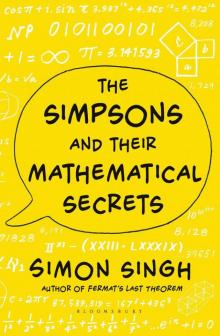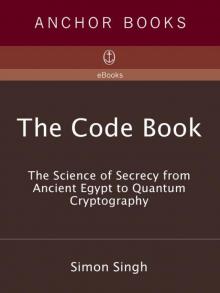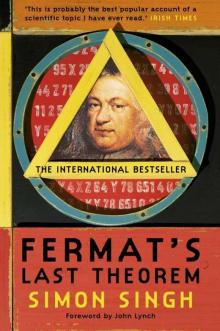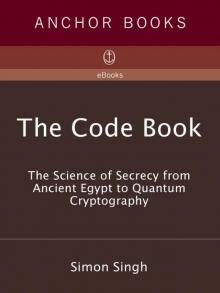- Home
- Simon Singh
Fermat's Last Theorem
Fermat's Last Theorem Read online
SIMON SINGH
Fermat’s Last Theorem
THE STORY OF A RIDDLE THAT CONFOUNDED THE
WORLD’S GREATEST MINDS FOR 358 YEARS
In memory
of
Pakhar Singh Birring
CONTENTS
Cover
Title Page
Dedication
Foreword
Preface
1 ‘I Think I’ll Stop Here’
2 The Riddler
3 A Mathematical Disgrace
4 Into Abstraction
5 Proof by Contradiction
6 The Secret Calculation
7 A Slight Problem
Epilogue Grand Unified Mathematics
Appendices
Suggestions for Further Reading
Index
About the Author
Also by the Author
Copyright
About the Publisher
Foreword
We finally met across a room, not crowded, but large enough to hold the entire Mathematics Department at Princeton on their occasions of great celebration. On that particular afternoon, there were not so very many people around, but enough for me to be uncertain as to which one was Andrew Wiles. After a few moments I picked out a shy-looking man, listening to the conversation around him, sipping tea, and indulging in the ritual gathering of minds that mathematicians the world over engage in at around four o’clock in the afternoon. He simply guessed who I was.
It was the end of an extraordinary week. I had met some of the finest mathematicians alive, and begun to gain an insight into their world. But despite every attempt to pin down Andrew Wiles, to speak to him, and to convince him to take part in a BBC Horizon documentary film on his achievement, this was our first meeting. This was the man who had recently announced that he had found the holy grail of mathematics; the man who claimed he had proved Fermat’s Last Theorem. As we spoke, Wiles had a distracted and withdrawn air about him, and although he was polite and friendly, it was clear that he wished me as far away from him as possible. He explained very simply that he could not possibly focus on anything but his work, which was at a critical stage, but perhaps later, when the current pressures had been resolved, he would be pleased to take part. I knew, and he knew I knew, that he was facing the collapse of his life’s ambition, and that the holy grail he had held was now being revealed as no more than a rather beautiful, valuable, but straightforward drinking vessel. He had found a flaw in his heralded proof.
The story of Fermat’s Last Theorem is unique. By the time I first met Andrew Wiles, I had come to realise that it is truly one of the greatest stories in the sphere of scientific or academic endeavour. I had seen the headlines in the summer of 1993, when the proof had put maths on the front pages of national newspapers around the world. At that time I had only a vague recollection of what the Last Theorem was, but saw that it was obviously something very special, and something that had the smell of a Horizon film to it. I spent the next weeks talking to many mathematicians: those closely involved in the story, or close to Andrew, and those who simply shared the thrill of witnessing a great moment in their field. All generously shared their insights into mathematical history, and patiently talked me through what little understanding I could achieve of the concepts involved. Rapidly it became clear that this was subject matter that perhaps only half a dozen people in the world could fully grasp. For a while I wondered if I was insane to attempt to make a film. But from those mathematicians I also learned of the rich history, and the deeper significance of Fermat to mathematics and its practitioners, and that, I realized, was where the real story lay.
I learned of the ancient Greek origins of the problem, and that Fermat’s Last Theorem was the Himalayan peak of number theory. I was introduced to the aesthetic beauty of maths, and I began to appreciate what it is to describe mathematics as the language of nature. Through Wiles’s contemporaries I grasped the herculean nature of his work in pulling together all the most recent techniques of number theory to apply to his proof. From his friends in Princeton I heard of the intricate progress of Andrew’s years of isolated study. I built up an extraordinary picture around Andrew Wiles, and the puzzle that dominated his life, but I seemed destined never to meet the man himself.
Although the maths involved in Wiles’s proof is some of the toughest in the world, I found that the beauty of Fermat’s Last Theorem lies in the fact that the problem itself is supremely simple to understand. It is a puzzle that is stated in terms familiar to every schoolchild. Pierre de Fermat was a man in the Renaissance tradition, who was at the centre of the rediscovery of ancient Greek knowledge, but he asked a question that the Greeks would not have thought to ask, and in so doing produced what became the hardest problem on earth for others to solve. Tantalisingly, he left a note for posterity suggesting that he had an answer, but not what it was. That was the beginning of the chase that lasted three centuries.
That time-span underlies the significance of this puzzle. It is hard to conceive of any problem, in any discipline of science, so simply and clearly stated that could have withstood the test of advancing knowledge for so long. Consider the leaps in understanding in physics, chemistry, biology, medicine and engineering that have occurred since the seventeenth century. We have progressed from ‘humours’ in medicine to gene-splicing, we have identified the fundamental atomic particles, and we have placed men on the moon, but in number theory Fermat’s Last Theorem remained inviolate.
For some time in my research I looked for a reason why the Last Theorem mattered to anyone but a mathematician, and why it would be important to make a programme about it. Maths has a multitude of practical applications, but in the case of number theory the most exciting uses that I was offered were in cryptography, in the design of acoustic baffling, and in communication from distant spacecraft. None of these seemed likely to draw in an audience. What was far more compelling were the mathematicians themselves, and the sense of passion that they all expressed when talking of Fermat.
Maths is one of the purest forms of thought, and to outsiders mathematicians may seem almost other-worldly. The thing that struck me in all my discussions with them was the extraordinary precision of their conversation. A question was rarely answered immediately, I would often have to wait while the precise structure of the answer was resolved in the mind, but it would then emerge, as articulate and careful a statement as I could have wished for. When I tackled Andrew’s friend Peter Sarnak on this, he explained that mathematicians simply hate to make a false statement. Of course they use intuition and inspiration, but formal statements have to be absolute. Proof is what lies at the heart of maths, and is what marks it out from other sciences. Other sciences have hypotheses that are tested against experimental evidence until they fail, and are overtaken by new hypotheses. In maths, absolute proof is the goal, and once something is proved, it is proved forever, with no room for change. In the Last Theorem, mathematicians had their greatest challenge of proof, and the person who found the answer would receive the adulation of the entire discipline.
Prizes were offered, and rivalry flourished. The Last Theorem has a rich history that touches death and deception, and it has even spurred on the development of maths. As the Harvard mathematician Barry Mazur has put it, Fermat added a certain ‘animus’ to those areas of maths that were associated with early attempts at the proof. Ironically, it turned out that just such an area of maths was central to Wiles’s final proof.
Gradually picking up an understanding of this unfamiliar field, I came to appreciate Fermat’s Last Theorem as central to, and even a parallel for the development of maths itself. Fermat was the father of modern number theory, and since his time mathematics had evolved, progressed and di
versified into many arcane areas, where new techniques had spawned new areas of maths, and become ends in themselves. As the centuries passed, the Last Theorem came to seem less and less relevant to the cutting edge of mathematical research, and more and more turned into a curiosity. But it is now clear that its centrality to maths never diminished.
Problems around numbers, such as the one Fermat posed, are like playground puzzles, and mathematicians like solving puzzles. To Andrew Wiles it was a very special puzzle, and nothing less than his life’s ambition. Thirty years before, as a child, he had been inspired by Fermat’s Last Theorem, having stumbled upon it in a public library book. His childhood and adulthood dream was to solve the problem, and when he first revealed a proof in that summer of 1993, it came at the end of seven years of dedicated work on the problem, a degree of focus and determination that is hard to imagine. Many of the techniques he used had not been created when he began. He also drew together the work of many fine mathematicians, linking ideas and creating concepts that others had feared to attempt. In a sense, reflected Barry Mazur, it turned out that everyone had been working on Fermat, but separately and without having it as a goal, for the proof had required all the power of modern maths to be brought to bear upon its solution. What Andrew had done was tie together once again areas of maths that had seemed far apart. His work therefore seemed to be a justification of all the diversification that maths had undergone since the problem had been stated.
At the heart of his proof of Fermat, Andrew had proved an idea known as the Taniyama-Shimura Conjecture, which created a new bridge between wildly different mathematical worlds. For many, the goal of one unified mathematics is supreme, and this was a glimpse of just such a world. So in proving Fermat, Andrew Wiles had cemented some of the most important number theory of the post-war period, and had secured the base of a pyramid of conjectures that were built upon it. This was no longer simply solving the longest-standing mathematical puzzle, but was pushing the very boundaries of mathematics itself. It was as if Fermat’s simple problem, born at a time when maths was in its infancy, had been waiting for this moment.
The story of Fermat had ended in the most spectacular fashion. For Andrew Wiles, it meant the end of professional isolation of a kind almost alien to maths, which is usually a collaborative activity. Ritual afternoon tea in mathematics institutes the world over is a time when ideas come together, and sharing insight before publication is the norm. Ken Ribet, a mathematician who was himself central to the proof, only half jokingly suggested to me that it is the insecurity of mathematicians that requires the support structure of their colleagues. Andrew Wiles had eschewed all that, and kept his work to himself in all but the final stages. That too was a measure of the importance of Fermat. He had a real driving passion to be the one who solved this problem, a passion strong enough to devote seven years of his life and keep his goal to himself. He had known that however irrelevant the problem had seemed, competition for Fermat had never lessened, and he could never have risked revealing what he was doing.
After weeks of researching the field, I had arrived in Princeton. For mathematicians, the level of emotion was intense. I had found a story of competition, success, isolation, genius, triumph, jealousy, intense pressure, loss and even tragedy. At the heart of that crucial Taniyama-Shimura Conjecture lay the tragic post-war life in Japan of Yutaka Taniyama, whose story I was privileged to hear from his close friend Goro Shimura. From Shimura too I learned of the notion of ‘goodness’ in maths, where things simply feel right, because they are good. Somehow, the sense of goodness pervaded the atmosphere of mathematics that summer. All were revelling in the glorious moment.
With all this in train, small wonder at the weight of responsibility that Andrew felt as the flaw had gradually emerged over the autumn of 1993. With the eyes of the world upon him, and his colleagues calling to have the proof made public, somehow, and only he knows how, he didn’t crack. He had moved from doing maths in privacy and at his own pace to suddenly working in public. Andrew is an intensely private man, who fought hard to keep his family sheltered from the storm that was breaking around him. Throughout that week while I was in Princeton, I called, I left notes at his office, on his doorstep, and with his friends; I even provided a gift of English tea and Marmite. But he resisted my overtures, until that chance meeting on the day of my departure. A quiet, intense conversation followed, that in the end lasted barely fifteen minutes.
When we parted that afternoon there was an understanding between us. If he managed to repair the proof, then he would come to me to discuss a film; I was prepared to wait. But as I flew home to London that night it seemed to me that the television programme was dead. No one had ever repaired a hole in the many attempted proofs of Fermat in three centuries. History was littered with false claims, and much as I wished that he would be the exception, it was hard to imagine Andrew as anything but another headstone in that mathematical graveyard.
A year later I received the call. After an extraordinary mathematical twist, and a flash of true insight and inspiration, Andrew had finally brought an end to Fermat in his professional life. A year after that, we found the time for him to devote to filming. By this time I had invited Simon Singh to join me in making the film, and together we spent time with Andrew, learning from the man himself the full story of those seven years of isolated study, and his year of hell that followed. As we filmed, Andrew told us, as he had told no one before, of his innermost feelings about what he had done; how for thirty years he had hung on to a childhood dream; how so much of the maths he had ever studied had been, without his really knowing it at the time, really a gathering of tools for the Fermat challenge that had dominated his career; how nothing would ever be the same; of his sense of loss for the problem that would no longer be his constant companion; and of the uplifting sense of release that he now felt. For a field in which the subject matter is technically about as difficult for a lay audience to understand as can be imagined, the level of emotional charge in our conversations was greater than any I have experienced in a career in science film making. For Andrew it was the end of a chapter in his life. For me it was a privilege to be close to it.
The film was transmitted on BBC Television as Horizon: Fermat’s Last Theorem. Simon Singh has now developed those insights and intimate conversations, together with the full richness of the Fermat story and the history and mathematics that have always hung around it, into this book, which is a complete and enlightening record of one of the greatest stories in human thinking.
John Lynch
Editor of BBC TV’s Horizon series
March 1997
Preface
The story of Fermat’s Last Theorem is inextricably linked with the history of mathematics, touching on all the major themes of number theory. It provides a unique insight into what drives mathematics and, perhaps more importantly, what inspires mathematicians. The Last Theorem is at the heart of an intriguing saga of courage, skulduggery, cunning and tragedy, involving all the greatest heroes of mathematics.
Fermat’s Last Theorem has its origins in the mathematics of ancient Greece, two thousand years before Pierre de Fermat constructed the problem in the form we know it today. Hence, it links the foundations of mathematics created by Pythagoras to the most sophisticated ideas in modern mathematics. In writing this book I have chosen a largely chronological structure which begins by describing the revolutionary ethos of the Pythagorean Brotherhood, and ends with Andrew Wiles’s personal story of his struggle to find a solution to Fermat’s conundrum.
Chapter 1 tells the story of Pythagoras, and describes how Pythagoras’ theorem is the direct ancestor of the Last Theorem. This chapter also discusses some of the fundamental concepts of mathematics which will recur throughout the book. Chapter 2 takes the story from ancient Greece to seventeenth-century France, where Pierre de Fermat created the most profound riddle in the history of mathematics. To convey the extraordinary character of Fermat and his contribution to mathematics, whi
ch goes far beyond the Last Theorem, I have spent several pages describing his life, and some of his other brilliant discoveries.
Chapters 3 and 4 describe some of the attempts to prove Fermat’s Last Theorem during the eighteenth, nineteenth and early twentieth centuries. Although these efforts ended in failure they led to a marvellous arsenal of mathematical techniques and tools, some of which have been integral to the very latest attempts to prove the Last Theorem. In addition to describing the mathematics I have devoted much of these chapters to the mathematicians who became obsessed by Fermat’s legacy. Their stories show how mathematicians were prepared to sacrifice everything in the search for truth, and how mathematics has evolved through the centuries.
The remaining chapters of the book chronicle the remarkable events of the last forty years which have revolutionised the study of Fermat’s Last Theorem. In particular Chapters 6 and 7 focus on the work of Andrew Wiles, whose breakthroughs in the last decade astonished the mathematical community. These later chapters are based on extensive interviews with Wiles. This was a unique opportunity for me to hear at first hand one of the most extraordinary intellectual journeys of the twentieth century and I hope that I have been able to convey the creativity and heroism that was required during Wiles’s ten-year ordeal.
In telling the tale of Pierre de Fermat and his baffling riddle I have tried to describe the mathematical concepts without resorting to equations, but inevitably x, y and z do occasionally rear their ugly heads. When equations do appear in the text I have endeavoured to provide sufficient explanation such that even readers with no background in mathematics will be able to understand their significance. For those readers with a slightly deeper knowledge of the subject I have provided a series of appendices which expand on the mathematical ideas contained in the main text. In addition I have included a list of further reading, which is generally aimed at providing the layperson with more detail about particular areas of mathematics.

 The Simpsons and Their Mathematical Secrets
The Simpsons and Their Mathematical Secrets The Code Book
The Code Book Fermat's Last Theorem
Fermat's Last Theorem The Code Book: The Science of Secrecy from Ancient Egypt to Quantum Cryptography
The Code Book: The Science of Secrecy from Ancient Egypt to Quantum Cryptography